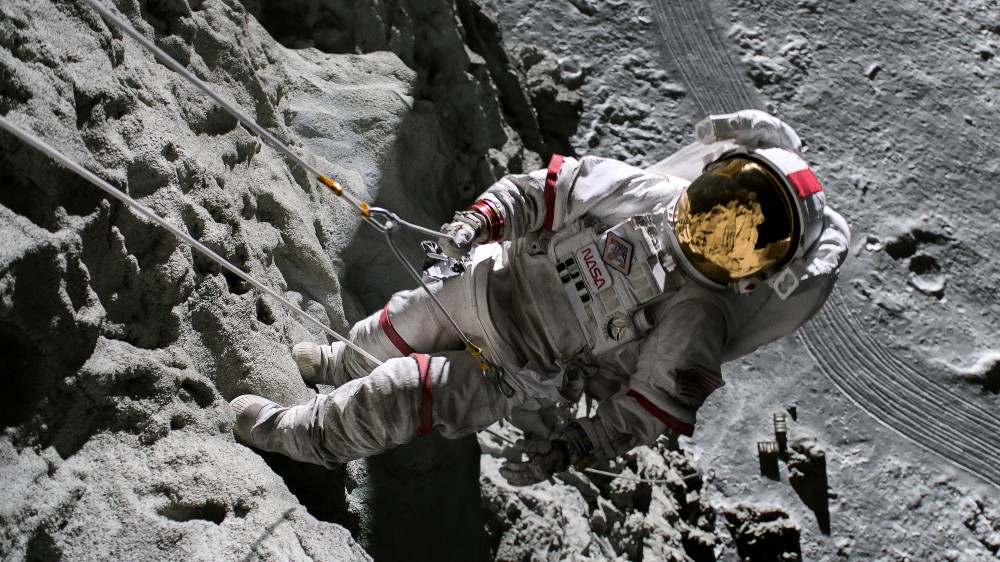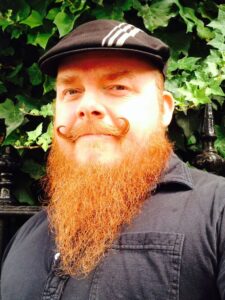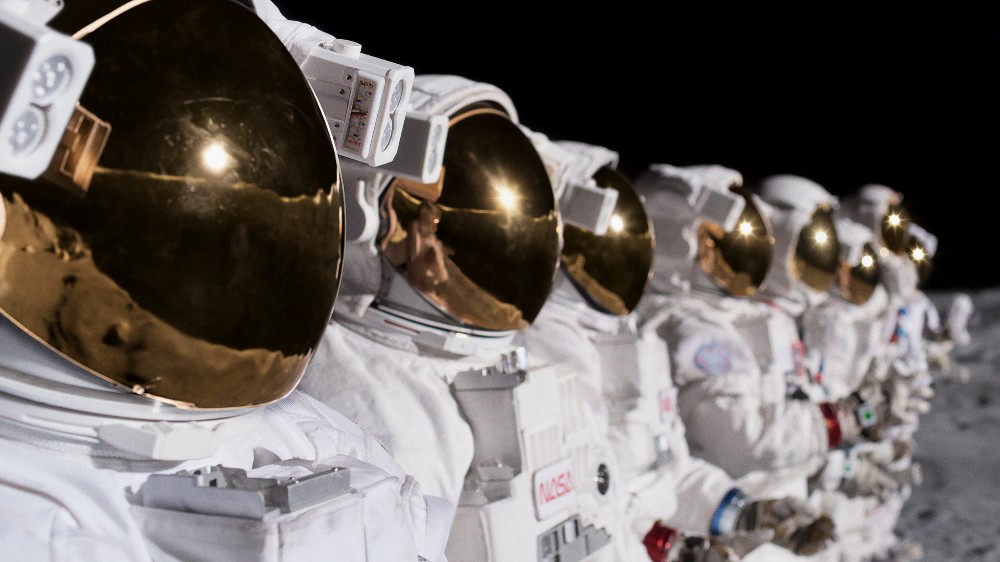
Traveling to the moon and seeing its lunar dust, impact craters, and utter vastness is something that only astronauts marvel at and witness up close. Thanks to technology and special visual effects, the mysteries of space and the neighboring planet we see up in the sky can be recreated in all its heavenly glory on screen.
For All Mankind VFX supervisor Jay Redd (AMPAS, VES) is the magic behind the celestial curtain creating digital effects that bring the moon and space to life in the show. However, Redd is quick to point out that recreating galactic goings-on is not done in a vacuum. It’s a collaborative team effort involving lights, costumes, production design, and most importantly the top brass at NASA.
Now in its sophomore season, Redd gets to feed his passion and further delve into space. Whether it’s removing a wire for Zero-G or flying ships on the dark side of the moon and a pretty cool effect with talk show host Johnny Carson on earth, there are about 1,600 visual effects shots generating a 3-D version of what’s written on the page.
Redd shares his secrets with Below The Line on how some of these awe-inspiring effects are conceived, from the reflections we see in the space helmet visors to rippling the lunar soil in solar storms.

Below The Line: What departments are you informed by when you create the digital shots on the moon?
Jay Redd: It’s almost every department. Before, visual effects used to be to take the (aerial) wires out, and it’s all done in camera. This is a combination of all of that, so we’re working with Jill Ohanneson for costumes about where the pick points might be in the actual suit in order for us to say we can paint that out or cover it up with some more fabric. Todd’s got safety lines that we paint out digitally to Dan who says this is all the wall I can build you, because we don’t have a big enough stage so we need to fill that in. Working with (cinematographer) Stephen McNutt about where the light is. One of the things I absolutely love about my work and my job is that I get to collaborate with all these fantastic talented people, then my own visual effects team comes from various studios around the world.
BTL: How does each department collaborate in creating the moon?
Redd: The shots on the moon take every department to make that image on the show. The cables that Molly Cobb (Sonya Walger) is hanging on involves our stunt coordinator Todd Schneider who has a lot of experience with astronauts and how micro-gravity works, and how rappelling works when you’re in 6Gs. There is a rappelling wall that is like 87 degrees (tilted) so Dan Bishop from our production designing team built this incredible lunar wall that Molly is able to scale down. We have a 75-foot crane up there shooting down and all below the bottom is blue screen and black screen for the surface of the moon. They are big shots with one big beautiful giant sunlight.
BTL: What effects on the spacesuits are digital?
Redd: The gold visor (on the space helmet) is showing some of the practical set, but it’s also showing the lights and the beams on the ceiling, which is not supposed to be on the moon! So we have to paint all that out and replace that with a visual effects CG visor to reflect that environment. A little secret about the show is 80 to 90 percent of the time when you see a visor, whether gold or clear, it’s been added in after the shot. You know when you see people’s sunglasses it shows the entire world including the camera when you’re taking a selfie. It’s the same problem with the visors, so it’s one of those kind of invisible effects we use for storytelling a lot. That visor is a very heavily digital creation.
BTL: Do you work directly with NASA to create an authenticity for the VFX?
Redd: We are so lucky, and I feel like a little kid because we have Garrett Reisman who is our technical consultant, and he’s actually an ex-NASA astronaut. He was on the Space Station for months, and he is ridiculously knowledgeable and approachable. I can text or write to him, and we can have discussions about what is physically accurate and what might have happened and then talking about poetic and dramatic license. He’s a fantastic resource. We also consult with Denise and Michael Okuda spent years doing design work with NASA and working on Star Trek the TV show. We like to say that we keep one foot in reality and then another foot in a little exploratory fantasy space but we strive to start being accurate.
BTL: What inspired the solar storm effect in the Season 2 premiere episode, “Every Little Thing”?
Redd: That’s a combination of practical and digital effects. We shot that in Long Beach (California) at an old Boeing 747 repair warehouse so it’s this giant building that two or three planes can actually park inside. We built a 70-foot by 120-foot kind of lunar sandbox with rocks from the art department and created regolith, which is lunar soil. Stephen McNutt, our main DoP for that sequence, put a giant 100K sunlight probably 200 feet away, then our rigging team built this giant black dubotine fabric space with an iris for the sun to come through. On the moon, the skies are black so we don’t shoot blue or green screen because then the moon starts to turn green so black sky everywhere with the fabric. We do big extensions on the moon adding backgrounds and craters.

Once that is set up we had to figure out how to get the surface to move a little bit with radiation in that solar storm. In the script it says, “the surface of the moon boils.” As an artist, that is so exciting to interpret. We wanted to make something that was beautiful and also a little bit scary and menacing. I went off and did a bunch of research on electrostatic radiation, ripples in sand dunes, water moving over sand in a time lapse to show this elegant way to show there’s movement across the surface without making it look so fantasy that you couldn’t believe it. I read a bunch of NASA documents about Apollo astronauts seeing dust floating on the surface when they’re leaving the moon and looking back as the sun is setting. There’s no atmosphere on the moon so what are we seeing?
Years later, it was understood that electrostatic would levitate tiny little pieces of dust off the surface. We went with that with our solar storm which was 1,000 times more than any of that! So that was the big inspiration to get dust to actually levitate off the ground but also form ripples as if the radiation was this relentless wave coming across the surface. We can see it touching their boots and moving around which is so dramatic. We had dozens of artists at Method Studios in Montreal working with us using my concept art to bring that alive.
BTL: There is also an effect on earth so to speak, featuring Johnny Carson.
Redd: There’s a scene where Tracy Stevens (Sarah Jones) is on The Tonight Show. Johnny puts his hand out and says, “Is that a ring on your finger?” and she extends her hand, and Johnny takes her hand and analyzes the ring. Clearly none of that could’ve happened. We shot Sarah against a green screen and matched the photography and the lighting with our DP. I worked with Sarah quite a bit on the rehearsal of that. The secret is we did a little split screen and I had a stand-in with Johnny’s sleeve and an arm. Then we made Johnny say a bunch of things where he uses our characters’ names. We’re doing a lot of deep fakes and cool processes there. Our ability to manipulate footage and making people say things they didn’t say is a fascinating advancement.
BTL: What effects are you most proud of that you questioned whether you could pull them off?
Redd: Honestly, there is a giant question mark if we could pull these off like the solar storm which turned out pretty cool. Our show has got a lot of challenges with the reality of making ships feel like they move right and astronauts working without gravity. But creating a scene of a space experience is something I’m really proud of because there’s a stark quality to it but it’s really easy to make it look computery or video gamey. We’re always walking that fine line. Also the sunrise on the moon in Episode 1 which is a very strange thing. It’s not like on earth where we wake up and see a purple sky with orange clouds changing to yellow and magenta. On the moon there’s no atmosphere so as soon as the sun peaks over the horizon it’s like somebody turned on the lights! There are big lunar environments created on this show.
BTL: Do you get to live out your personal passions about space?
Redd: Being a little kid when Close Encounters, Star Wars and 2001: A Space Odyssey came out, all of these films as a child, just being able to look up into these dark skies in Utah where I grew up and just fascinated by the moon, fascinated by the space shuttle program and the Apollo program. The Apollo landing on the moon happened before I was born, which was 1972, but regardless, early sci-fi, I just had a passion about space travel and being in zero-G. I also grew up watching Cosmos on PBS with Carl Sagan and so he was a childhood hero of mine.
I was lucky enough to work on Contact which was one of my favorite books in college. I was working at Sony Pictures Imageworks and pitched an idea for the opening shot of Contact, that big pull back shot through the universe through the eye and I was able to do it. I’ve just been surrounded by space my whole life so when this show came up, I couldn’t possibly say “No.” I pinch myself daily about how much learning and knowledge and exploration I get to do. It’s crazy they pay me for this job!
For All Mankind is available to stream on Apple TV+. All photos courtesy Apple.





